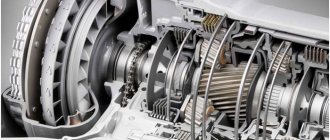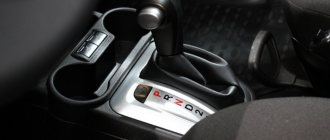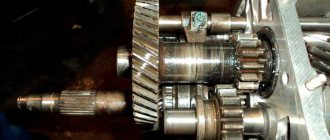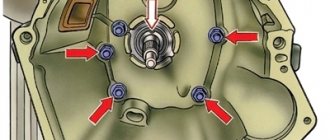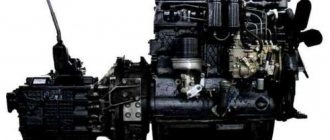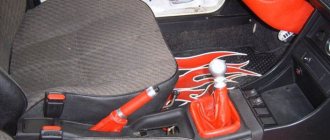Do-it-yourself automatic transmission repair will bring many surprises to the car owner. In addition to being impressed by the talent of the designers, you can find out what the previous owner hid when selling the car. For example, that the oil was never changed, so everything inside the machine died. Or that the box is used and repaired by a master with the credo “it will do.” High-quality repairs do not tolerate haste and negligence, so do not forget to bring tea with you.
Signs of breakdown
Problems with automatic transmissions are divided into electrical faults or hardware wear. You can detect a breakdown by hearing, smell and sight. The automatic transmission should switch smoothly, quietly, without delay. The appearance of uncomfortable sensations indicates improper operation of the transmission.
A fluid leak or “Check Engine” signal is a clear sign of problems with the gearbox. If you do not pay attention to the signs that the car gives, the automatic transmission will fail and force the owner to fork out for expensive repairs or replacement.
| Sign of breakdown | What to do |
| Oil leak. | Look for the source of the leak: · inspect the bottom; · check the tightness of the drain plug; · if oil leaks between the engine and automatic transmission, you need to disassemble the torque converter. The problem is the oil seal, oil pump bushing, or damage to the donut housing. |
| Overfilling or underfilling oil. | Adjust the level. If you drive for a long time with the wrong fluid level, the gearbox begins to starve of oil and wears out quickly. |
| The oil is opaque, with a burnt odor. | Go through the machine. Replace bearings, bushings, automatic transmission clutches. Clean the valve body and solenoids. Check the condition of the planetary gear. |
| The tray contains large metal or plastic particles and a lot of chips. | |
| Delay when switching, hesitation when overtaking, lack of switching. | Clean the valve body and solenoids. Replace consumables. |
| Jerks, jerks, impacts while shifting gears. | Clean the valve body and solenoids. Replace consumables. Check the clutch clearance and the condition of the pistons. |
| The engine stalls during the transition to "D". | Check the wheel blades of the torque converter and clean the valve body. |
| Jerking, jerking while moving. | The freewheel in the torque converter is faulty |
| Automatic transmission slipping, i.e. When the car accelerates, the speedometer and tachometer needles do not move synchronously. | Clean the valve body and solenoids. Replace consumables and clutches. |
| During acceleration, engine speed fluctuates, acceleration is slow. | Check the torque converter wheel blades. |
| Computer errors, emergency mode. | 1. Go through the box. Errors occur when the wiring, sensor, or solenoid are damaged. 2. The software may be outdated; you need to reset the adaptation. |
| There is no reverse movement, or any speed, or if the car does not respond to the gas pedal. | Check the torque converter and the corresponding clutch package: clutches, pistons, O-rings, brake band, drum housing |
You can analyze the signs of a breakdown only by knowing the structure and operating principle of the automatic transmission. For example, in what cases does slippage occur:
- when starting, but then it drives normally. Most likely the problem is the wear of the donut hub. The splines are very worn out, and at high speeds the shaft slips;
- during ascent at 5 - 8 speeds. Slipping occurs due to a lack of fluid or severe wear of the oil pump or valve body;
- when changing gears. Clutches slip due to lack of oil or problems with solenoids.
https://youtu.be/Z3ck1MSxpeM
Recommendations for use
- Eliminate slippage. The automatic transmission must be operated without slipping, otherwise this will significantly reduce its service life. This is especially true for those who like to drift on ice. Regardless of the road surface, the possibility of slipping is excluded.
- If this is your first time using a machine, keep in mind that the neutral speed on it does not just turn on. The neutral mode is activated only when the car is parked without the engine running; in other cases it cannot be turned on.
- Vehicles with automatic transmissions cannot tow other vehicles. The same goes for trailers. Installing a trailer or other vehicle in tow will negatively affect the service life of the vehicle as a whole.
- Automatic transmission never. Over time, this can lead to complete failure of the unit. The same applies to towing a car - if for some reason you cannot start, then your only option to get to the service station is to call a tow truck. If the box suddenly starts working in emergency mode, but at least somehow works, then you need to go to the nearest service station. We strongly do not recommend driving for more than 5 kilometers with an incorrectly functioning gearbox.
Automatic transmission repair diagram
If symptoms of a malfunction appear, do not rush to open the machine. Before repairing, carry out self-diagnosis:
- Inspect the automatic transmission for leaks.
- Clear fault codes.
- Check the oil quality and level. Remove the pan. If the liquid has lost its clarity, do a test partial replacement.
- Check line pressure.
- Ring electrical circuits to check the serviceability of wiring and external sensors.
To more accurately determine the problem, you cannot do without disassembling the automatic transmission. Wash the removed box from dirt and proceed to the bulkhead:
- Unscrew the pan.
- Remove the filter.
- Disconnect the wiring harnesses and the control unit.
- Unscrew the oil pump.
- Remove the planetary gear with clutch drums.
It is impossible to repair a torque converter without special equipment. It is better to entrust the unit to a specialist. The “bagel” can be sent by a transport company if the technical center is located in another city.
After disassembling the automatic transmission, proceed to the next stage of repair, troubleshooting. Look at what parts are worn out. Rubber seals can be immediately thrown away:
- pay attention to the condition of the clutches, pistons, the presence of burrs on steel discs and brake bands;
- check the integrity of the gears and pins of the planetary gear;
- inspect the oil pump components;
- check bearings, bushings, shaft play;
- measure the resistance of the solenoids.
After replacing all faulty parts and consumables, reassemble the automatic transmission. Install the torque converter and box in place, not forgetting to connect the drives, electrical cables, and tubes. Replace the removed transfer case, cardan, subframe, etc. After repair, fill in fresh oil and check the level.
Where to begin?
It is necessary to adjust the vehicle's idle speed and all its pedals. Next, you should check the fluid in the transmission. It should not have a repulsive odor or unnatural color. Such signs mean that the automatic transmission is seriously damaged. The presence of bubbles means there is too much liquid, causing it to foam. If the liquid is milky in color, this means it is leaking, to eliminate which you need to find the cable connecting the throttle valve to the box.
Most common repair items
In powerful cars with automatic transmissions, wear on the torque converter is common if the driver likes to press the gas pedal to the floor. For sports automatic transmission settings with locking in 1st - 3rd gear, you have to pay for service after 40 - 60,000 km. Once every 150 - 250,000 km, the torque converter requires repair to replace consumables.
During each scheduled repair of an automatic transmission, the clutches are changed. If the piston does not fully compress the friction and steel discs, they begin to slip. They are heating up. They wear out. The oil and valve body become contaminated, which leads to an even greater loss of pressure. The repair consists of replacing damaged discs, pistons, consumables and cleaning the valve body.
Electrically, the main problem is the solenoids, through which dirty oil flows back and forth. Fine dust, not stopped by the filter, settles in the channels of the solenoids and valve body. The valves begin to jam, dangle, and stick. Repair consists of cleaning or replacement.
Causes of malfunctions
Most automatic transmission parts are subject to natural wear, and this is one of the causes of malfunctions.
In the torque converter, pump wheel seals, turbine wheel hub splines, bearings, and clutch friction linings wear out. The wheel blades may break and the clutch may jam.
In the system of friction clutches and brakes, the most vulnerable elements are linings, seals, and friction discs.
In the valve body distribution module, the channels and valves wear out due to natural aging or improper operation, and they become clogged with wear products. There may also be problems with the valve return spring or its winding (break, short, increase in resistance).
In the electronic control system, it is not uncommon for wiring connections to break due to oxidation of contacts or short circuits, as well as breaks in the wiring itself.
All automatic transmission elements are interconnected, and a malfunction, including natural wear and tear of at least one of them, can cause a chain reaction and lead to large-scale breakdowns. Thus, the electronic automatic transmission control unit in modern cars is part of the hydraulic plate. When the linings of friction clutches wear out, wear products enter the oil and clog solenoids, channels and valves of the valve body, bore soft aluminum channels, cause sticking of valve plungers, and this, in turn, leads to disruption of the normal operation of the clutches and their accelerated wear, overheating electronics.
Premature gearbox failures are caused by insufficiently careful operation of the vehicle, frequent overheating of the oil, its contamination, and a decrease in the level due to leaks. The most unfavorable factors for automatic transmission:
- aggressive, sporty driving style with sharp acceleration and braking;
- frequent slipping of the car, very slow movement when caught in a traffic jam, clogging of the ventilation radiator and other circumstances leading to overheating of the gearbox and working fluid;
- quick start of the car in the cold season, when the gearbox does not have time to warm up;
- violation of the frequency of changing transmission oil, oil filters and other consumables.
Preparation for repair
Before starting automatic transmission repair, collect information about your transmission and write down the symptoms of the malfunction. Read forums, reports with a similar problem. Study the manuals. Understand the structure and design features of your machine.
Prepare a set of wrenches, hexagons, ratchets, Torx sockets, and rust remover. Find a helper. Take a camera to record all repair actions and not get confused in the disassembly order. Lay out the parts in the order of dismantling. For small ones, make an accordion out of paper.
The automatic transmission is removed on a lift or inspection pit. Jacks and supports may be required.
It is better to order consumables and replacement parts after troubleshooting. If you purchase before opening the automatic transmission, then you will still have to re-order and wait for the delivery of an important part.
What do experts recommend?
For automatic transmission servicing, experts recommend looking for a service that specializes specifically in automatic transmission repairs, since only there is a complete set of equipment, ranging from a diagnostic stand to special equipment for such a complex type of repair.
In addition, the staff of such centers are specially trained and have daily experience working with such precision equipment as hydraulic drives, not to mention the electronic control unit. They also know the specifics of working with automatic transmissions of different brands.
Automatic transmission repair
You won't be able to quickly repair an automatic transmission with your own hands. Theoretical knowledge provides the basis, but in practice many questions always arise. Be prepared to spend more than one day repairing your box. Dismantling alone will take a beginner about 4 hours.
Automatic transmission dismantling
The automatic transmission weighs a lot, has an awkward shape, and, most often, is located in a small space. So, to get to the automatic transmission in a Kia Rio, you need to remove the air filter, battery, engine control unit, and crankcase. In a Land Rover, the exhaust pipe, engine and automatic transmission mounts, cardan shafts, and transfer case will be in the way.
Before dismantling, drain the liquid through the drain plug. Look at what vehicle systems the automatic transmission is connected to. Disconnect the radiator pipes, electrical connectors, and control rods. Be careful not to damage the fasteners or break the wires. Do not use a sledgehammer or chisel for repairs.
Get to the junction between the engine and the torque converter. To access the “donut”, for example, on an Audi A4, you need to remove the wheels, drives, and driveshaft. The subframe that holds the automatic transmission and engine can also interfere. In this case, proceed in stages: prop up the box, unscrew the cushions from the subframe, and the subframe from the body. The torque converter and flywheel mount can be hidden in the flywheel housing hatch or the starter niche in the automatic transmission housing.
Do not remove the automatic transmission before the torque converter. The input shaft splines may be damaged. Do not let the transmission fall to the floor.
Unscrew the automatic transmission and internal combustion engine mounting bolts, do not forget about the selector cable. Remove the box.
Do-it-yourself valve body repair
Self-repair of the hydraulic unit involves flushing the channels and replacing consumables. More complex procedures:
- checking the pressure in the channels;
- drilling holes for plungers;
- restoration of the slab
There is no point in doing it without professional equipment. Even specialists in difficult cases will not be able to guarantee that the valve body will come back to life after repair. Most often, such control units are immediately replaced with used ones.
To access the valve body, disassembling the entire automatic transmission is not necessary. It is enough to remove the pan, filter, disconnect the wiring, and turn off the temperature sensors. Although there are exceptions, for example, the TF-80SC, where the valve body is “hidden” in the planetary mechanism.
General repair algorithm after removing the pan and filter:
- Unscrew the valve body bolts.
- Unscrew the solenoid bolts, remove the mounting brackets and remove the solenoid valves.
- Remove the top cover of the stove.
- Inspect the separator plate. If the tracks are “eaten” by dirt, the part needs to be replaced.
- Remove the springs, plungers, and balls.
- Wash all parts, clean the stove from dirty oil and blockages.
- Assess wear. If there are burrs on the plungers, loss of elasticity of the springs, broken channels - replace them.
- Assemble the hydraulic unit according to the diagram so as not to lose a single ball.
- Install new consumables.
- Screw on the solenoids.
- Wipe the seat of the pan with a clean, lint-free cloth to prevent dirt from getting into the automatic transmission.
- Reinstall the valve plate.
- Install a new filter, a washed pan with a new gasket.
- Fill the oil and check the level.
Do-it-yourself hydraulic unit repair
Do-it-yourself automatic transmission torque converter repair
Without repairing the torque converter, dismantling the automatic transmission and replacing consumables will have a short-lived positive effect. After all, the “donut” will contain a worn-out coupling, a worn out oil seal, and a defective bushing. After repairing the automatic transmission, fresh oil will quickly become contaminated, and the pressure will leak even more forcefully. As a result, after such a rebuild, problems will return or new ones will appear.
The torque converter can only be opened using a special machine that will carefully cut the weld seam of the housing. You will also need equipment to repair the locking clutch. The Mercedes automatic transmission “donut” uses a multi-plate clutch, but its removal and installation requires experienced hands. In addition, the assembled assembly must be tested for leaks, runout, and balanced.
By welding the seam, you can determine whether the torque converter was opened, and how professional the repair was.
Repairs without experience and equipment in a garage can only be carried out by brave souls who do not feel the burden of buying a new torque converter to replace a damaged one. If you like dynamic and playful driving with an automatic transmission, do not skimp on sending the “donut” for service.
Installation stages
Before installing the transmission, a number of measures must be taken:
- It is necessary to thoroughly rinse the radiator, all pipelines and lines of the oil cooling system with clean gasoline;
- Service the torque converter and pour 1000 ml of transformer oil into it;
- Place the automatic transmission horizontally and on the input shaft, carefully install the torque converter (GDT) until it is completely seated.
Installation.
- When installing the automatic transmission, do not allow a large angle of inclination so that the unsecured gas turbine engine does not move to the side;
- Using guide centering pins, we connect the automatic transmission to the engine;
- We tighten two opposite bolts and check the tightness of its connection to the engine along the entire diameter of the automatic transmission;
- We check through the starter window that the torque converter is installed correctly; to do this, it must be turned along the axis;
- We connect to each other, rods, pipes, electrics, oil pipes;
- We check everything carefully again;
- Pour 5.5 - 6.5 liters (depending on the brand of the unit) of oil into the box.
Removing the gearbox
For dismantling you will need a lift or inspection pit, a special jack and keys. The automatic transmission weighs a lot, so it would be useful to have the help of strong guys to move the box to the right place. It is located in the lower part of the car, so to dismantle it you need to partially disassemble the car, that is, remove its individual parts from the top, side and bottom. And in this case, you cannot do without special devices.
Next you need:
- disconnect cables and tubes;
- unscrew the bolts;
- move the automatic transmission;
- evaluate the problem and finally proceed to repair.
It is not necessary to drain the oil before removing the transmission. But in this case, you need to place a special container under it so that the liquid does not spill onto the surface.
Dismantling must be done carefully, without sudden movements.
Diagnostics of the electronic control system
If a problem is found in this part, then it may not be necessary to remove and disassemble the automatic transmission. Diagnostics in this case is carried out by a control unit that monitors the automatic transmission sensors, its gear ratio and the resistance of the output targets.
Various sensors send signals to the transmission computer. The latter, in turn, saves all codes of emerging problems, which are decrypted by a special scanner.
